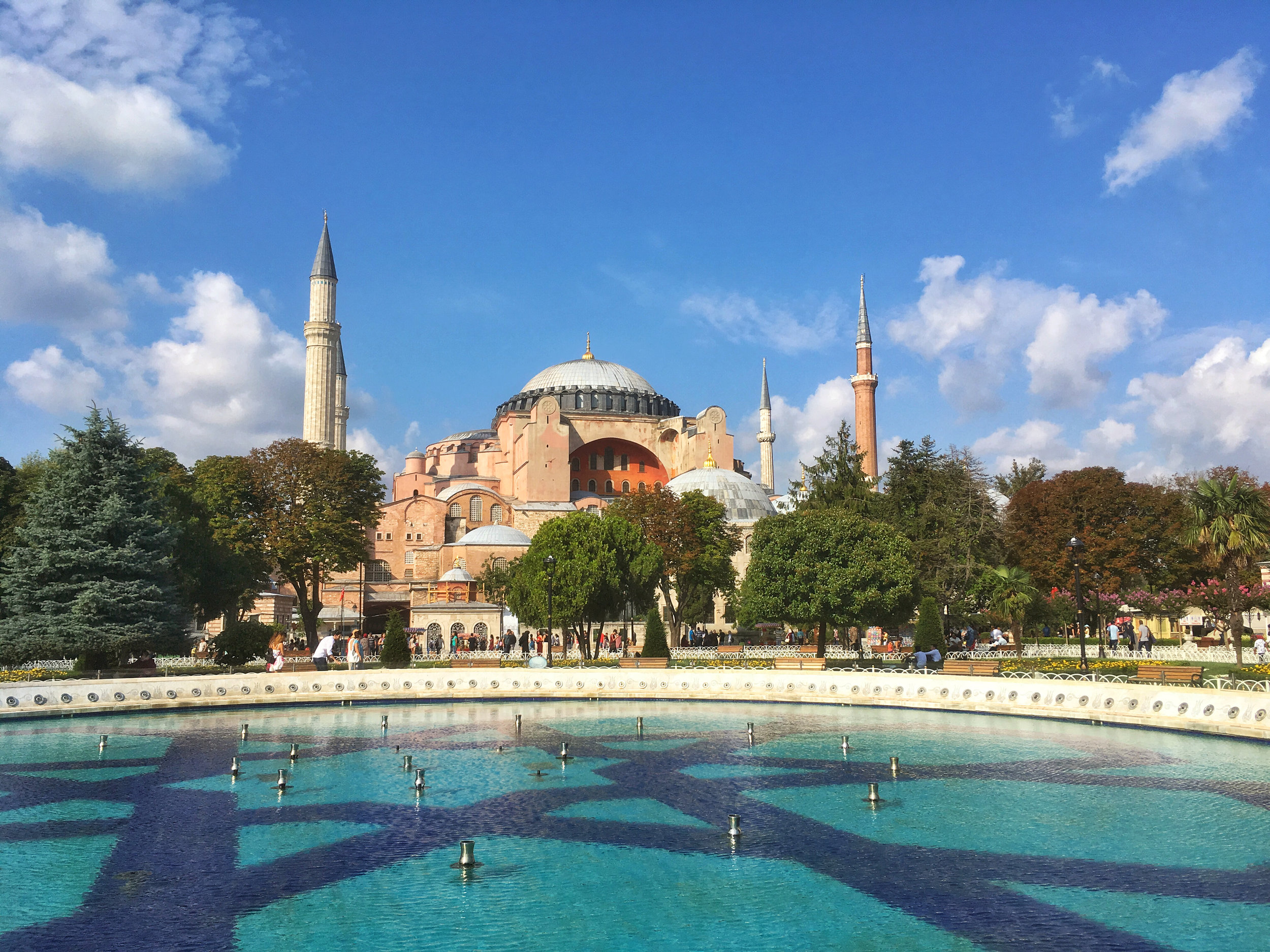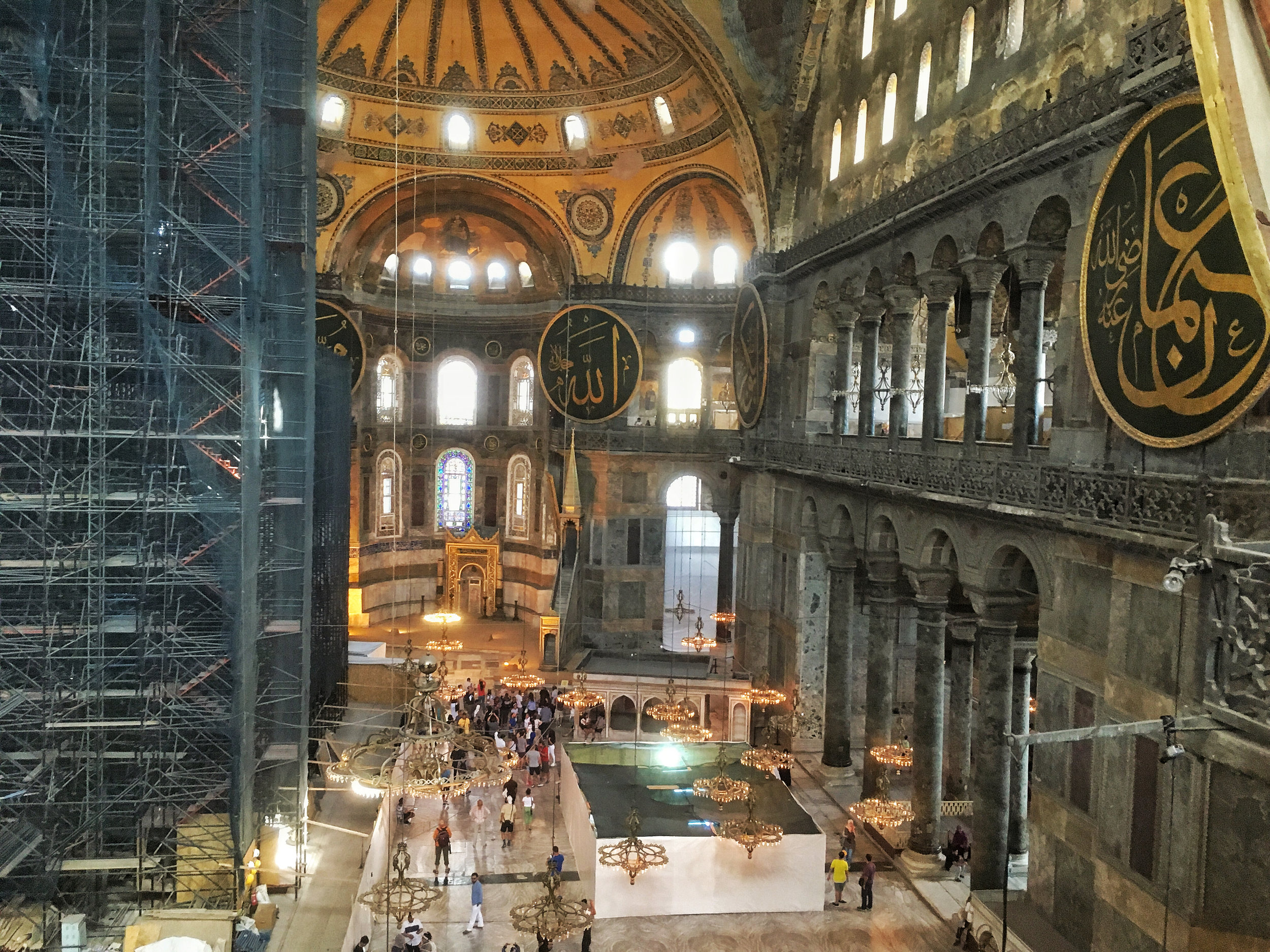Istanbul is a sprawling city, teeming with life - yet burdened by a complex cultural and political transformation. At any moment it’s both modern and ancient, beautiful and grimy, progressive and backwards. It is a hard place to get a read on, but through the vibrant colors of the city; the primary red flags, shimmering golden motifs, deep blue Bosporus, and jet black underbelly, I found interesting narratives of this new incarnation of old Constantinople.
Red:
In a country as tumultuous as Turkey these days, nothing remains more constant then its age old market traditions. Today, the Grand Bazaar may cater more to the tastes of tourists then Silk Road merchants, yet it continues to be the standard barer for open trade in the city. I spent days wandering the rows of spice vendors and lantern hawkers, all promising the best deal on the most authentic flavor. As unauthentic as the cheapo lamps and piles of bulk bin sumac might be, there is something exhilarating about cruising these bright patterned halls. I couldn’t help but get caught up smelling the dunes of paprika, sampling rose water & pistachio Turkish Delight, and snapping some photos of the rug and scarf mosaics lining the walls. With mahogany colored tea flying in every direction and a kebab shop on each corner, the hustle and bustle still felt as authentic as ever. Each stall flies a small Turkish flag, and whether this is by choice or law, it really drove home the old world spirit of Istanbul.
The Grand Bazaar - What it lacks in authenticity these days it makes up for with delicious samples!
Gold:
Entering into Ayasophya: the cathedral - turned mosque - turned museum, radiates in a way that only a civilization’s centerpiece can. Its looming domes and oversize features distorted my sense of human scale. The imposing medallions’ gilded scripture bared down on me with a sense of extreme might and power. The juxtaposition is not lost however, as a golden mosaic of haloed baby Jesus floats between two of these mighty medallions; a relic of the thousand years this structure spent as the largest cathedral in the world. Outside, the sun drenched domes of the great mosques of Istanbul, ricocheted the rising sound of their minarets as evening call to prayer commenced. I was pleasantly surprised to find that the two flagship mosques of the city, Ayasophya and the Blue Mosque had orchestrated their efforts into a battle style call and response drawing a massive crowed.
Mosques are designed in a way that scales very logically, and that is well documented in these two mega structures. It also turns out the minaret loud speaker supplier has horns that scale in lock step. In a city of 20+ million people, the vast majority of whom do not speak or understand Arabic, it is pretty intense that this Metallica scale event occurs five times a day.
Throughout the city, perhaps it’s most impressive quality is a relentless intersection of civilizations and cultures. Walking through what is now Sultan Ahmet square, and the former Hippodrome of Constantinople during the Roman Empier’s heyday, I was struck by the wild array of artifacts rising out from what was once street level. The serpent column, ripped from the ancient Greek sanctuary of Delphi by Constantine the Great is immediately followed by the even further removed Obalisc of Thodosius, hauled from Egypt and still standing after inter-continental shipping and 3500 years of display. Around the perimeter of the square riot ready military police stand guard with armored vehicles as tour bus after tour bus of Chinese visitors unload wielding sun umbrellas and comically large telescoping camera lenses.
Looking Good For 3500 Years as a Pigeon Poop Target
Inside the museums surrounding the square, beautifully ornate Ottoman Qurans are on display highlighting the meticulous calligraphy and gilded pictorial detail. Without a religious bone in my body I was still drawn into the texts with a true sense of wonder. Having grown up in modern western society the Quran has often been framed in a negative light, sometimes justly, yet more often not so, and upon seeing these unbelievable works of art it was hard to reconcile the misalignment of this messaging.
Ottoman Quran at the Museum of Turkish and Islamic Arts
Beyond the museums and history, a new era of glamour glitzes around newly constructed shopping centers and high end boutiques. In the ritzier sections of the city evidence of a new direction for Turkish tourism moseys. A wealthy Arab tourist base, attracted by the falling lira and conservative governance can be seen shifting the focus of Istanbul’s tourism industry from Western cultural reveler towards Middle-Eastern dollars.
Blue:
Splitting Istanbul across two continents, the Bosporus has brought both plenty and plague to the cities along it’s shores for millennia. In it’s modern incarnation the Bosporus is home to a ceaseless stream of people mover ferries, shuttling the masses of Istanbul to and fro across the continental divide; and for me it offered an amazing vantage from which to view the urban sprawl. The strait is paramount to the city, its aorta. And the great markets, mosques, and palaces, new and old, all vie for its views and salty breeze. Along the Asian shores, students and dog walkers take in the tranquil parks throughout the homey and well landscaped Kadıköy neighborhood. Across the water, back in Europe, fisherman line busy bridges, dangling lines dangerously close to the faces of tourists eating seafood at the stalls below. Above, seagulls circle in hopes of scoring some leftover bait crudo. Though separating the city physically, the Bosporus likely plays one of the most crucial roles in holding Istanbul together.
Sunset Cruising on the Bosphorus
Black:
There is a darkness that has washed over Istanbul, and though it may not be obvious on first glance, on deeper inspection a black veil has been draped over the city’s streets, buildings, and people. I had only heard wonderful things about Istanbul - that it would be a paradise of modernity and liberalism after a substantial period of conservative observance. A city of revelry, even debauchery. I have reason to believe this was the case at some point, but what I found did not echo these descriptions.
Over the last 15 years, Prime Minister turned President Recep Tayyip Erdogan, has been both a blessing and a curse to a struggling Turkish state, but as his political hold over the nation has grown stronger, his true intentions have solidified into a nefarious platform. He had been heralded for rebuilding Turkey’s failing economy and as a champion of western democracy in the east during the early 00’s, especially as western - middle-east relations floundered. Erdogan’s push for changes in the governmental structure, the rise of state sponsored Islamic conservatism, and the removal of party enemies was viewed as a small price to pay for an ally in the region. This all changed in 2016 after a failed military coup to over-though his government justified sweeping reforms. Hundreds of thousands have been pushed out of the government or jailed and Erdogan has now cemented himself into what appears to be a leader for life type role.
My question came to be: “How did this happen?” How could a country of 80 million, established on the basis of secular rule almost 100 years ago, find itself strangled in the grips of a strongman and supporter of hard line conservative Islam in about a decade? The answers I received sounded strikingly familiar and came as a wake-up call to the implications of politics at home. Erdogan built his support throughout the country on a populist, nationalistic platform. He has used an intensely conservative religious doctrine to empower the suppression of opposition, minorities, and women and used this invigorated religious base to justify otherwise unjustifiable actions. What began with political strong arming has snowballed into Greek Orthodox Turks being spit on in the streets for not wearing a Hijab, Wikipedia being banned, and state run media all but eradicating views beyond its own from the public.
A Familiar Face These Days
Populist politics, coupled with nationalistic rhetoric and misguided religious justification should not feel like foreign practices to any reader of this blog. And Turkey’s spiral into proxy dictatorship shouldn’t feel too far fetched from a possible future 15 years down the line from today. This is not a path we should aspire to and it’s on everyone, everywhere to ensure it does not slowly creep its way into normalcy.




